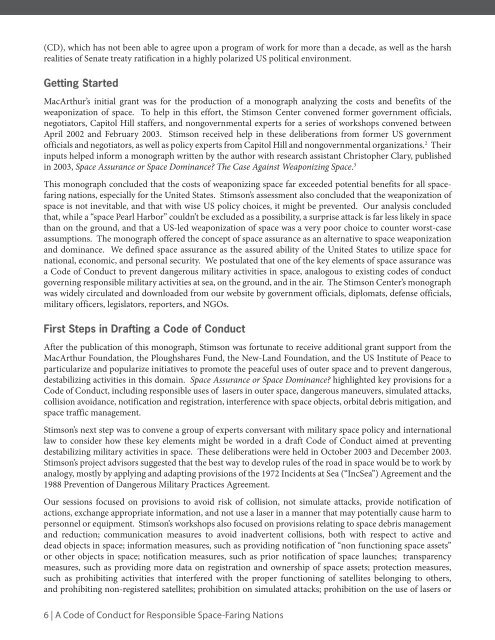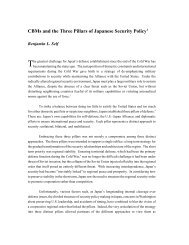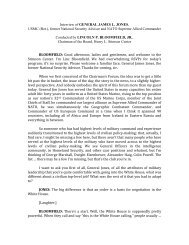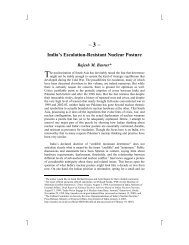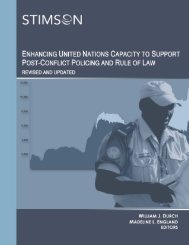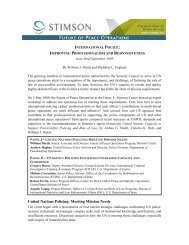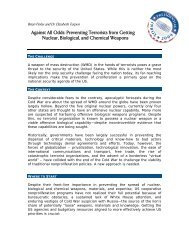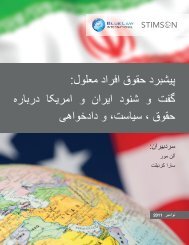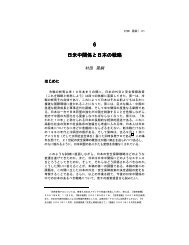A Case Study in Policy Entrepreneurship - The Stimson Center
A Case Study in Policy Entrepreneurship - The Stimson Center
A Case Study in Policy Entrepreneurship - The Stimson Center
You also want an ePaper? Increase the reach of your titles
YUMPU automatically turns print PDFs into web optimized ePapers that Google loves.
(CD), which has not been able to agree upon a program of work for more than a decade, as well as the harsh<br />
realities of Senate treaty ratification <strong>in</strong> a highly polarized US political environment.<br />
Gett<strong>in</strong>g Started<br />
MacArthur’s <strong>in</strong>itial grant was for the production of a monograph analyz<strong>in</strong>g the costs and benefits of the<br />
weaponization of space. To help <strong>in</strong> this effort, the <strong>Stimson</strong> <strong>Center</strong> convened former government officials,<br />
negotiators, Capitol Hill staffers, and nongovernmental experts for a series of workshops convened between<br />
April 2002 and February 2003. <strong>Stimson</strong> received help <strong>in</strong> these deliberations from former US government<br />
officials and negotiators, as well as policy experts from Capitol Hill and nongovernmental organizations. 2 <strong>The</strong>ir<br />
<strong>in</strong>puts helped <strong>in</strong>form a monograph written by the author with research assistant Christopher Clary, published<br />
<strong>in</strong> 2003, Space Assurance or Space Dom<strong>in</strong>ance? <strong>The</strong> <strong>Case</strong> Aga<strong>in</strong>st Weaponiz<strong>in</strong>g Space. 3<br />
This monograph concluded that the costs of weaponiz<strong>in</strong>g space far exceeded potential benefits for all spacefar<strong>in</strong>g<br />
nations, especially for the United States. <strong>Stimson</strong>’s assessment also concluded that the weaponization of<br />
space is not <strong>in</strong>evitable, and that with wise US policy choices, it might be prevented. Our analysis concluded<br />
that, while a “space Pearl Harbor” couldn’t be excluded as a possibility, a surprise attack is far less likely <strong>in</strong> space<br />
than on the ground, and that a US-led weaponization of space was a very poor choice to counter worst-case<br />
assumptions. <strong>The</strong> monograph offered the concept of space assurance as an alternative to space weaponization<br />
and dom<strong>in</strong>ance. We def<strong>in</strong>ed space assurance as the assured ability of the United States to utilize space for<br />
national, economic, and personal security. We postulated that one of the key elements of space assurance was<br />
a Code of Conduct to prevent dangerous military activities <strong>in</strong> space, analogous to exist<strong>in</strong>g codes of conduct<br />
govern<strong>in</strong>g responsible military activities at sea, on the ground, and <strong>in</strong> the air. <strong>The</strong> <strong>Stimson</strong> <strong>Center</strong>’s monograph<br />
was widely circulated and downloaded from our website by government officials, diplomats, defense officials,<br />
military officers, legislators, reporters, and NGOs.<br />
First Steps <strong>in</strong> Draft<strong>in</strong>g a Code of Conduct<br />
After the publication of this monograph, <strong>Stimson</strong> was fortunate to receive additional grant support from the<br />
MacArthur Foundation, the Ploughshares Fund, the New-Land Foundation, and the US Institute of Peace to<br />
particularize and popularize <strong>in</strong>itiatives to promote the peaceful uses of outer space and to prevent dangerous,<br />
destabiliz<strong>in</strong>g activities <strong>in</strong> this doma<strong>in</strong>. Space Assurance or Space Dom<strong>in</strong>ance? highlighted key provisions for a<br />
Code of Conduct, <strong>in</strong>clud<strong>in</strong>g responsible uses of lasers <strong>in</strong> outer space, dangerous maneuvers, simulated attacks,<br />
collision avoidance, notification and registration, <strong>in</strong>terference with space objects, orbital debris mitigation, and<br />
space traffic management.<br />
<strong>Stimson</strong>’s next step was to convene a group of experts conversant with military space policy and <strong>in</strong>ternational<br />
law to consider how these key elements might be worded <strong>in</strong> a draft Code of Conduct aimed at prevent<strong>in</strong>g<br />
destabiliz<strong>in</strong>g military activities <strong>in</strong> space. <strong>The</strong>se deliberations were held <strong>in</strong> October 2003 and December 2003.<br />
<strong>Stimson</strong>’s project advisors suggested that the best way to develop rules of the road <strong>in</strong> space would be to work by<br />
analogy, mostly by apply<strong>in</strong>g and adapt<strong>in</strong>g provisions of the 1972 Incidents at Sea (“IncSea”) Agreement and the<br />
1988 Prevention of Dangerous Military Practices Agreement.<br />
Our sessions focused on provisions to avoid risk of collision, not simulate attacks, provide notification of<br />
actions, exchange appropriate <strong>in</strong>formation, and not use a laser <strong>in</strong> a manner that may potentially cause harm to<br />
personnel or equipment. <strong>Stimson</strong>’s workshops also focused on provisions relat<strong>in</strong>g to space debris management<br />
and reduction; communication measures to avoid <strong>in</strong>advertent collisions, both with respect to active and<br />
dead objects <strong>in</strong> space; <strong>in</strong>formation measures, such as provid<strong>in</strong>g notification of “non function<strong>in</strong>g space assets”<br />
or other objects <strong>in</strong> space; notification measures, such as prior notification of space launches; transparency<br />
measures, such as provid<strong>in</strong>g more data on registration and ownership of space assets; protection measures,<br />
such as prohibit<strong>in</strong>g activities that <strong>in</strong>terfered with the proper function<strong>in</strong>g of satellites belong<strong>in</strong>g to others,<br />
and prohibit<strong>in</strong>g non-registered satellites; prohibition on simulated attacks; prohibition on the use of lasers or<br />
6 | A Code of Conduct for Responsible Space-Far<strong>in</strong>g Nations


